Houseplants add a beautiful ambiance to our homescapes, with cool, green foliage, elegant forms, and interesting textures – and ones that flower add delightful flair.
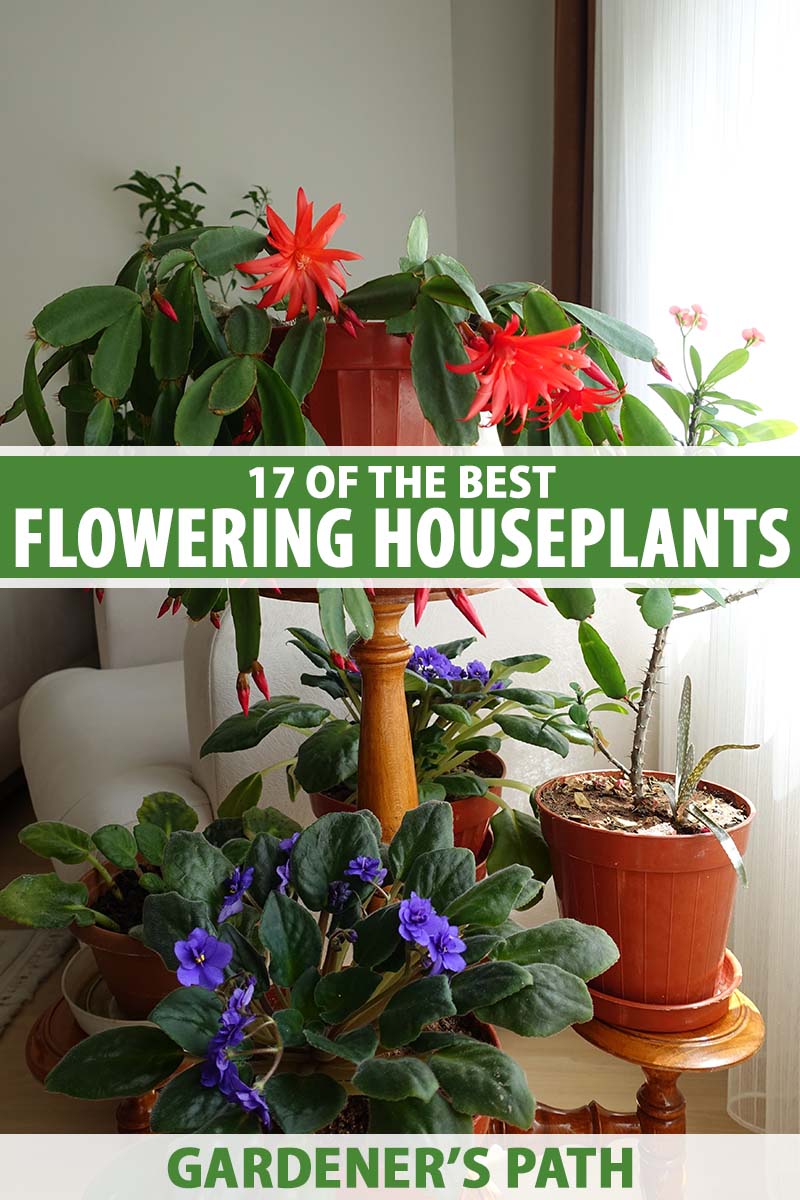
We link to vendors to help you find relevant products. If you buy from one of our links, we may earn a commission.
Many perennials native to tropical or subtropical regions are right at home in our cozy interiors.
When given the right light, temperature, and water, they produce colorful blooms or bracts, with some that bloom year-round.
And few things brighten a home more than a showy display of foliage with pretty, and perhaps perfumed, blossoms!
For some interesting floral ideas for your decor, join us now for a look at 17 of our favorite flowering houseplants.
Here’s what we’re looking at:
17 of the Best Flowering Houseplants
Most houseplants are easily cultivated, provided they receive adequate light and water, have nutritious soil to grow in and a well-draining container, and aren’t subject to cold or hot breezes.

As a broad rule of thumb, they prefer bright but indirect light. Avoid locations with hot sun which can dry plants and scorch leaves, but always refer to the growing instructions that come with your plant to give them the optimal conditions they need to thrive.
Also, if you’d like more detailed information, we have many specific growing guides you can refer to for the best care and cultivation tips – look for the links in the plant’s description below.
Now let’s look at 17 of our favorite flowering houseplants!
1. Abutilon
Also known as flowering maple thanks to its maple-like leaves, abutilon (Abutilon spp.) is a member of the mallow family that produces pretty, hibiscus-like blooms in shades of red, salmon, white, and yellow.
Vigorous growers that make attractive houseplants, abutilon grows up to five feet tall and should be pruned annually to keep plants bushy and at a manageable size.
Plants require a sunny spot between 60 and 80°F for continuous bud set – a south-facing window is ideal.
‘Souvenir de Bonn’ features salmon pink flowers with eye-catching variegated foliage.
‘Souvenir de Bonn’ plants are available at Walmart in six-inch pots.
2. African Violet
African violets (Streptocarpus sect. Saintpaulia) have long been popular houseplants, producing richly colored blooms of blue, mauve, maroon, pink, purple, and white that blossom year-round in the right conditions.
Standard-sized plants grow eight to 26 inches tall with a similar spread and require bright, indirect light, and temperatures between 60 and 70°F.
These plants are low maintenance but benefit from regular deadheading and soil that stays lightly moist but not wet – our guide on how to grow and care for African violets has all the details for healthy plants.
You can find Optimara® African violets in a variety of colors, available as a four-pack of four-inch pots from Hirt’s Gardens via Walmart. The colors you receive will be a surprise!
3. Anthurium
With attractive glossy green leaves and long-lasting, waxy spathes in shades of mauve, orange, pink, red, or white, anthuriums (Anthurium andraeanum), are attractive, easy-care houseplants.
Some species are foliage plants but A. andraeanum aka flamingo lily is the species most commonly grown for its attractive spathes.
Plants grow up to three feet tall and require medium to bright light with well-draining and evenly moist soil. They prefer temperatures of 78 to 90°F during the day and 70 to 75°F at night.
For complete cultivation details, be sure to read our guide on how to grow and care for anthurium houseplants.
You can find specimens with red spathes available from Nature Hills Nursery in four-inch containers.
If pink is more your style, you’re sure to enjoy ‘Sweet Dream Pink,’ which you can find available at FastGrowingTrees.com in a decorative white container.
4. Arabian Jasmine
Many types of jasmine make wonderful houseplants that are fast-growing and low-maintenance, and Arabian jasmine (Jasminum sambac) is one of the best for a brightly lit location.
The waxy, star-shaped blooms are highly fragrant and plants are excellent climbers for a trellis or they may be allowed to trail from hanging baskets. This species is also featured in our guide to the best fragrant houseplants.
Arabian jasmine grows to a height and width of five feet, and benefits from a light pruning in autumn or winter to keep plants tidy within a manageable size.
Arabian jasmine is available in two-and-a-half quart pots at Home Depot.
You can learn more about growing jasmine indoors in our guide.
5. Bromeliad
Bromeliads are members of the Bromeliaceae family, with brightly colored basal rosettes of burgundy, mauve, orange, pink, scarlet, and yellow that rise above plump, waxy leaves (bracts) of glossy green.
The true flowers are small and insignificant – it’s the neon rosettes that add a fantastic tropical touch.
If you’re new to these dazzling plants, our guide to growing and caring for bromeliads indoors has all the advice you need.
Bromeliads may be epiphytic or terrestrial – referring to air plants and those grown in soil – and they enjoy a brightly lit spot out of direct sunlight, with temperatures in the region of 70 to 80°F, depending on the species.
Guzmania lingulate ‘Scarlet Star’ features a bright red flower surrounded by deep green leaves, and grows to about 10 inches tall.
You can find ‘Scarlet Star’ in six-inch pots available at Nature Hills Nursery.
6. Calamondin Orange
A dwarf hybrid of mandarin orange and kumquat trees, calamondin orange (Citrus x microcarpa) bears sweetly fragrant white blossoms with small orange fruits – both blossoms and fruits are often seen on the tree at the same time.
Their small size, reaching four feet tall and wide, makes an excellent choice for container cultivation.
The tart fruits are sour but edible, and suitable for use in tangy marmalades or as a substitute for lemons in a variety of dishes and drinks.
Provide calamondin with evenly moist soil and bright to intense light. These plants thrive in temperatures ranging from 70 to 90°F.
You can find one- to two-, three- to four-, and four- to five-foot-tall potted trees available at FastGrowingTrees.com.
7. Christmas Cactus
A favorite over the winter holiday season, Christmas cactuses (Schlumbergera x buckleyi) develop gorgeous blooms in colors of mauve, orange, pink, red, white, and yellow.
The long-living plants need bright but indirect light, well-draining soil, and temperatures between 70 to 80°F. They typically grow six to 12 inches tall with a 12 to 24 inch spread.
We have several guides to get the most of these epiphytes, and how to grow and care for Christmas cactuses is a good place to start.
Six-and-a-half-inch potted plants with lovely red flowers are available at Walmart.
8. Clivia
From the same family as amaryllis, clivia (Clivia miniata), is a flowering bulb that develops strappy leaves of glossy green and beautiful clusters of blooms in shades of orange or yellow.
Also known as fire lily, plants bloom indoors for weeks in late winter, and develop buds best when slightly root-bound in small pots.
They need bright, indirect light, temps of 65 to 80°F, and a period of dormancy with temperatures of 40 to 55°F for up to eight weeks prior to flowering.
Our guide on how to grow and care for clivia houseplants has all the details you need.
You can find plants with variegated foliage and bright orange flowers in one-gallon pots available via Walmart.
9. Cyclamen
Potted cyclamen plants (Cyclamen persica) make popular winter gifts, featuring pink, purple, red, white, or bicolored flowers.
Heart-shaped green, or mottled silver and green foliage emerges in early winter and flowering follows soon after.
The colorful blooms are held on upright flower stalks above the foliage, providing an eye-catching pop of cold-season color.
When grown as a houseplant, cyclamen reaches three to 14 inches tall, with a similar spread, depending on the cultivar. You’ll find more information in our guide to growing cyclamen.
These plants require organically rich, well-draining soil, bright, indirect light, and daytime temperatures of 60 to 65°F.
Plants from the Latinia® series bloom in late fall and early winter and reach 10 to 14 inches tall and wide.
You can find a set of four red Latinia® plants in four-inch pots available from Home Depot.
10. False Shamrock
Known as false or purple shamrock for its gorgeous, triangular leaves of deep purple, Oxalis traingularis also produces dainty clusters of contrasting, pale lilac flowers that last for weeks.
An eye-catching and distinctive addition to your winter holiday decor, plants grow up to 12 inches tall with a width of 24 inches and are easily started from corms.
Place in a brightly lit location away from drying heat vents. Plants thrive in temperatures between 65 to 85°F.
You can find a growing kit that includes six corms, a decorative planter, and planting medium, available at Home Depot.
Read more about this plant here.
11. Gloxinia
An old-fashioned charmer, gloxinia (Sinningia speciosa) features bold, bell-shaped blooms in rich shades of blue, mauve, pink, purple, or white that last for weeks.
In medium to bright indirect light and temps of 65 to 75°F, they bloom in late winter or early spring, and soil should be kept lightly moist. Plants grow to 18 inches with a 24-inch spread.
After flowering, allow plants a dormancy period. Gradually withhold water, then move to a cool, dark cupboard after the foliage dies off for approximately two to three months.
When new growth resumes, repot with fresh soil, place in a bright location, and resume regular watering.
You can find a Brocade Mix of gloxinia seeds in red, blue, and white blooms available in packets of 200 from Walmart.
12. Hoya
Also known as waxflowers, hoyas (Hoya spp.) are trailing or climbing vines, featuring succulent, sometimes crinkled leaves that are often variegated, and beautiful, tight clusters of sweetly scented, waxy blooms.
Flower colors include burgundy, near-black, orange, pink, white, and yellow, depending on the variety.
Bright, indirect light and a temperature of around 70°F is required for bud set indoors, and because most indoor species are epiphytes, well-draining soil is a must.
You can find cultivation details in our guide to growing and caring for hoya houseplants.
Hoya gracilis (syn. H. memoria) has raspberry-colored flower clusters with the sweet smell of caramel, and burgundy tinged leaves on vines that may trail up to 36 inches.
Hoya Gracilis in Hanging Basket
It’s available in four-inch hanging baskets from Walmart.
13. Ixora
A handsome tropical shrub, ixora (Ixora coccinea) is also called flame of the woods or jungle geranium for its magnificent flower clusters in shades of orange, pink, red, or yellow.
The leathery foliage emerges with bronze tones and ages into a gorgeous glossy green on plants that grow two to four feet tall and spread two to three feet.
Provide ixora with bright light, temperatures above 60°F, and water thoroughly, then allow the soil surface to dry before another application.
Blooming year-round, a little selective pruning helps to keep plants compact and full – use a light touch to trim and shape stems that aren’t in flower during the winter.
‘Maui Red’ is a compact cultivar that features bright red flowers. A set of 10 starter plants in two-inch cells are available at Walmart.
14. Kalanchoe
An easy-care succulent, florist’s kalanchoe aka flaming Katy (Kalanchoe blossfeldiana) has lovely, glossy green scallop-shaped leaves and pretty, long-lasting umbels of blooms in shades of orange, pink, red, white, and yellow.
These plants prefer temperatures of 60 and 75°F and bright, indirect light in well-draining, sandy soil that should be kept lightly moist during the growing season. Reduce watering to the occasional, light application in winter.
Plants grow up to 18 inches tall and wide. For complete cultivation details, refer to our guide to growing flaming Katy. You can also find out how to encourage yours to rebloom here.
You can find flaming Katy plants with yellow flowers in two-and-a-half-inch pots available via Walmart.
Or you can opt for a three-pack of plants in four-inch pots available from Home Depot.
This is a “grab bag” option and the flowers may be coral, orange, red, white, or yellow.
15. Moth Orchid
Moth orchids (Phalaenopsis spp.) have attractive, strap-like foliage and feature flowers in a variety of different colors.
These epiphytes have long-lasting blooms that appear from late summer to early spring.
Provided with a well-draining growing medium specifically for orchids, bright indirect light, and temperatures of around 80°F, moth orchids are easy to care for and can be encouraged to rebloom.
If you’d like to add a stunning orchid to your home, you can find Phalaenopsis in 10-inch pots available from FastGrowingTrees.com.
Choose from white, purple, salmon, or watercolor blue.
And check out our guide to growing moth orchids for full cultivation details.
16. Peace Lily
Featuring attractive, deep green leaves and showy white spathes, peace lilies (Spathiphyllum) are easy-care plants that do best in bright, indirect light and temps of 65 to 80°F.
Peace lilies typically grow from one to four feet tall and wide, but there are smaller dwarf cultivars as well as ones that reach up to six feet.
For something with a unique twist, this variegated variety grows one to two feet tall and has beautiful, bright green foliage adorned with white streaks and stripes.
Plants in six-inch containers are available from Perfect Plants Nursery.
For complete care and maintenance details, read our guide on how to grow and care for peace lilies.
17. Pelargonium
Commonly called geraniums, pelargoniums (Pelargonium spp.) are highly popular bedding and garden plants with brightly colored globes of flowers in burgundy, mauve, orange, pink, red, and white.
The attractive foliage can be lightly scented or highly aromatic and often takes on burgundy and red tones in colder weather outdoors.
They easily transition into attractive and aromatic houseplants when propagated from cuttings or brought indoors for winter – our guide on how to propagate geraniums from stem cuttings will help you to start your own indoor plants.
Place in a bright window and remember to deadhead regularly for continuous blooms. Indoors, geraniums can grow up to 24 inches tall with an 18-inch spread.
Cultivars like ‘Citronella’ are prized for the citrusy fragrance of their leaves.
You can find ‘Citronella’ plants available at Burpee.
Colorful and Low Maintenance
Our favorite flowering houseplants come in a variety of colors and sizes, are low maintenance, and some even have the added bonus of fragrance!

For best results, refer to each plant’s specific growing requirements to provide for the correct amount of type of light, water, and soil they need for healthy growth.
Do you have a favorite flowering houseplant not listed here? Let us know about it in the comments section below.
And to learn more about houseplant care and cultivation, add these guides to your reading list next:
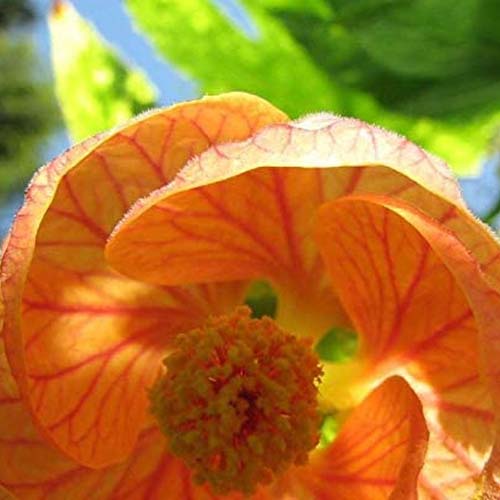

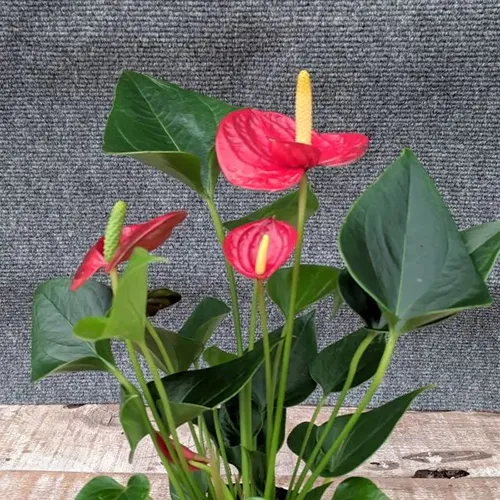
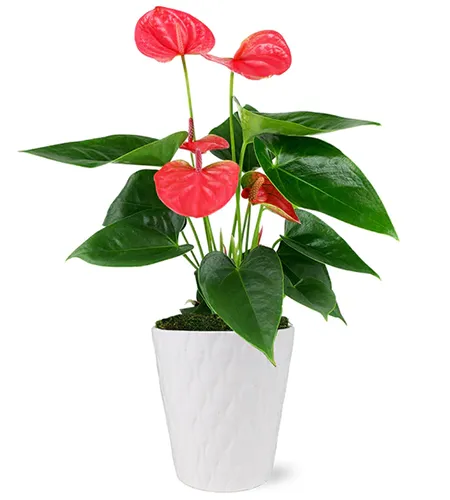
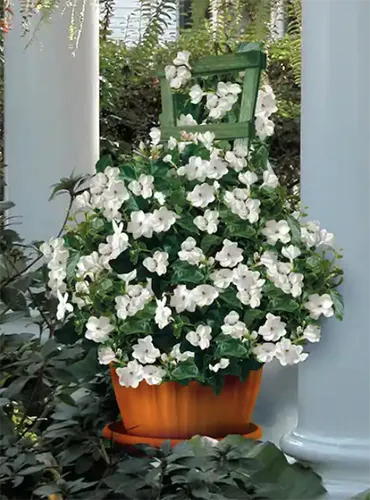
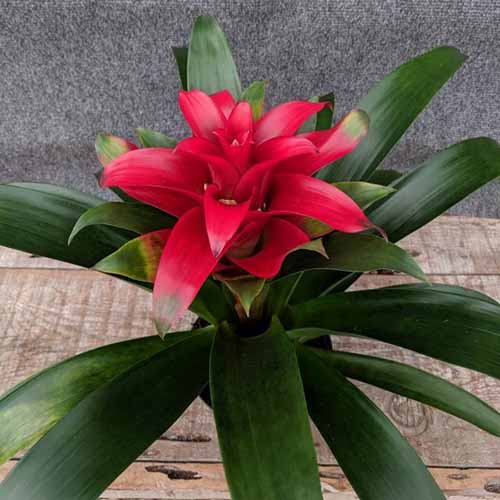




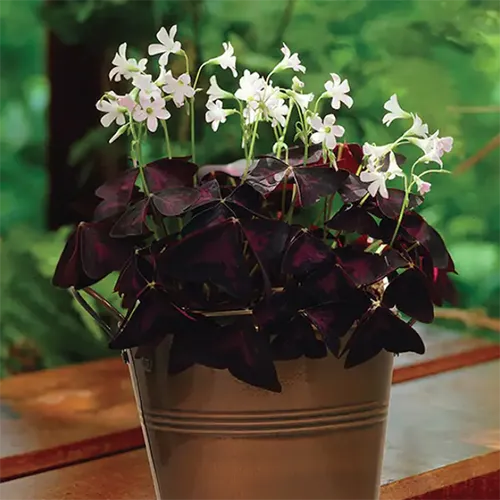
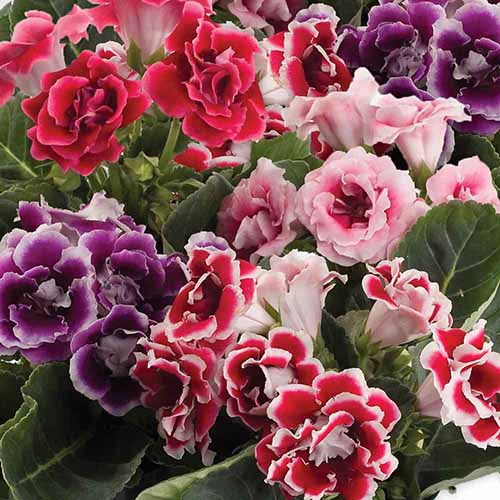
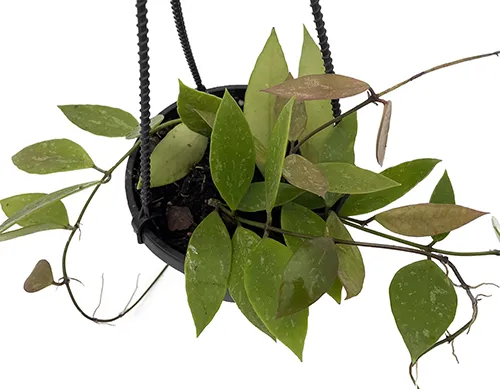
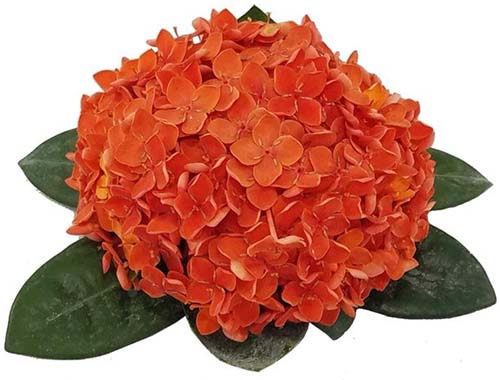
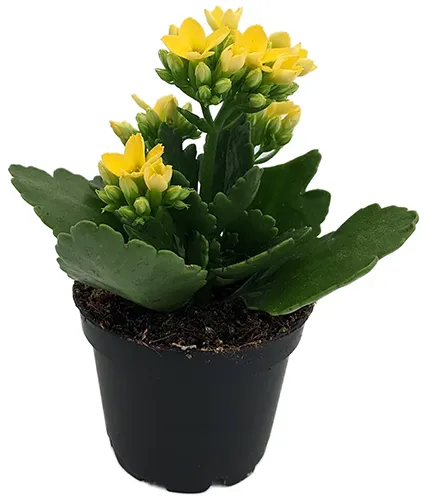
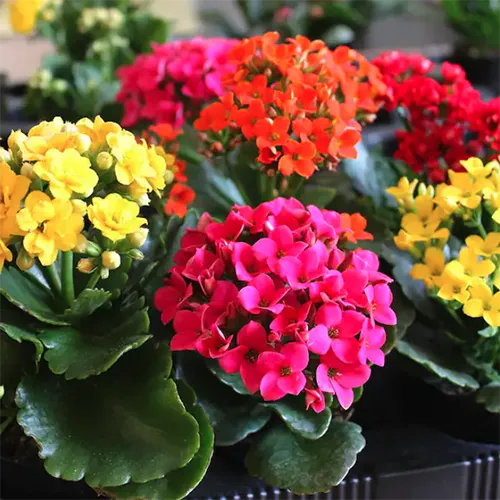
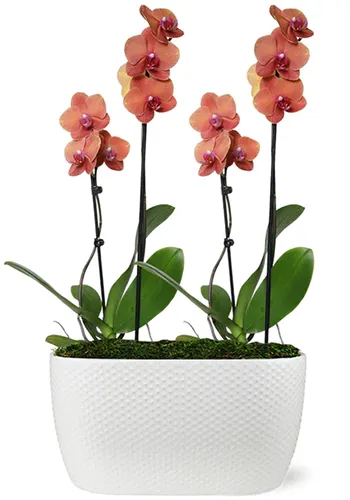
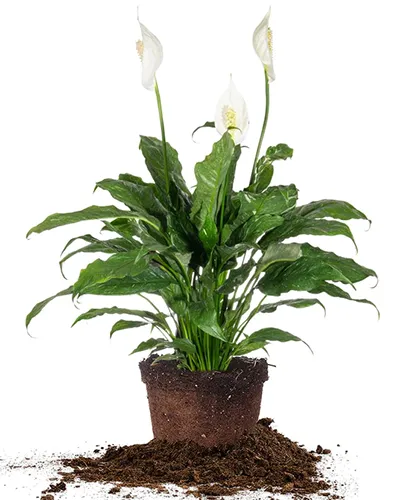
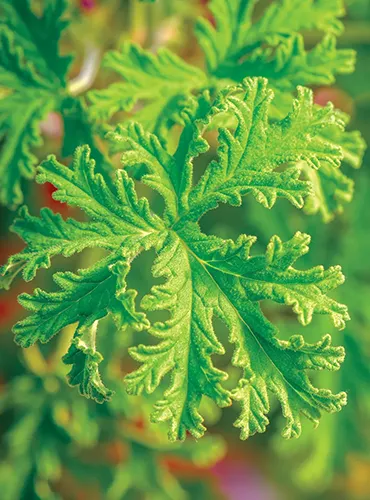
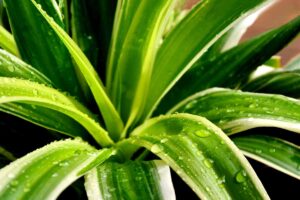
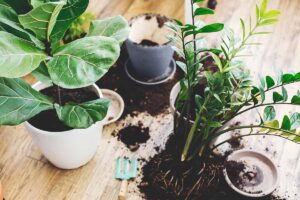
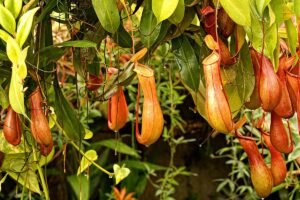
This is an excellent post about houseplants, and it is perfectly explained. It will be very useful to us. Thank you very much.
Thanks Swapnil, glad you liked it!
Aren’t philodendrons,ivy’s and geraniums a good houseplant?
Hi Mindy, philodendrons and ivies are good houseplants, but not outstanding for flowering indoors… geraniums are included in 17th selection, Pelargoniums.
Thanks for asking!